MXA RACE TEST: THE REAL TEST OF THE 2021 GASGAS MC 250F
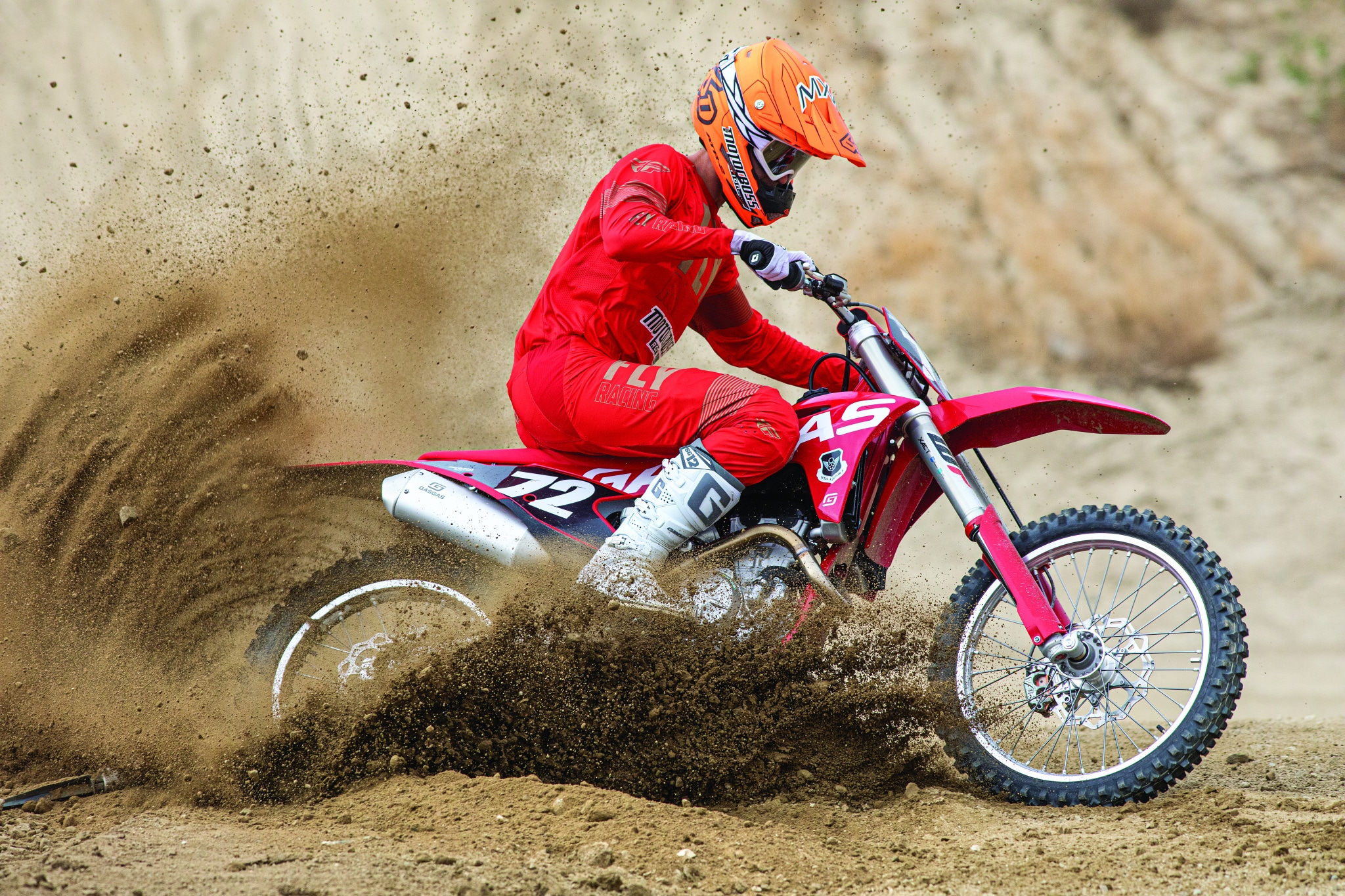
Q: FIRST AND FOREMOST, IS THE 2021 GASGAS MC 250F BETTER THAN THE 2020 GASGAS MC 250F?
A: In 2019, Stefan Pierer bought the Spanish brand (which the Torrot Group owned) and threw away everything but the name and the trials bikes. Did Pierer really spend a boatload of money just for a name? Pretty much. The only GasGas motocross bike MXA has tested in the last 48 years was Damon Bradshaw’s 2019 GasGas XC300. To say it nicely, we didn’t care much for it, even with all the work that Damon had done to turn the off-road bike into a motocross bike. Bottom line, apart from the GasGas name, the only thing that Stefan Pierer got out of the deal was the GasGas trials bike line. As for all the previous GasGas bikes, the technology was bought by Rieju, who rebranded the existing 2020 GasGas bikes as Riejus.
With the GasGas name wrapped up, Pierer added the GasGas brand to his platform-sharing lineup. Yes, he could have developed an all-new bike that was vastly different from his KTM and Husky brands, but that would have been a bad business decision. His costs would have skyrocketed with new casting molds, extensive R&D time and a lengthy delay in getting a totally new bike built from scratch. By borrowing the frames, engines, suspension, hubs, swingarm, throttle bodies, electronics and subframes from KTM and Husky, Pierer would benefit from economy of scale. In other words, buying in bulk.
We understand the 2021 GasGas MC 250F isn’t all KTM or all Husky, because there are some differences that make the bike handle differently, change the powerband and lower the retail price; however, there are a boatload of similarities under the red plastic. 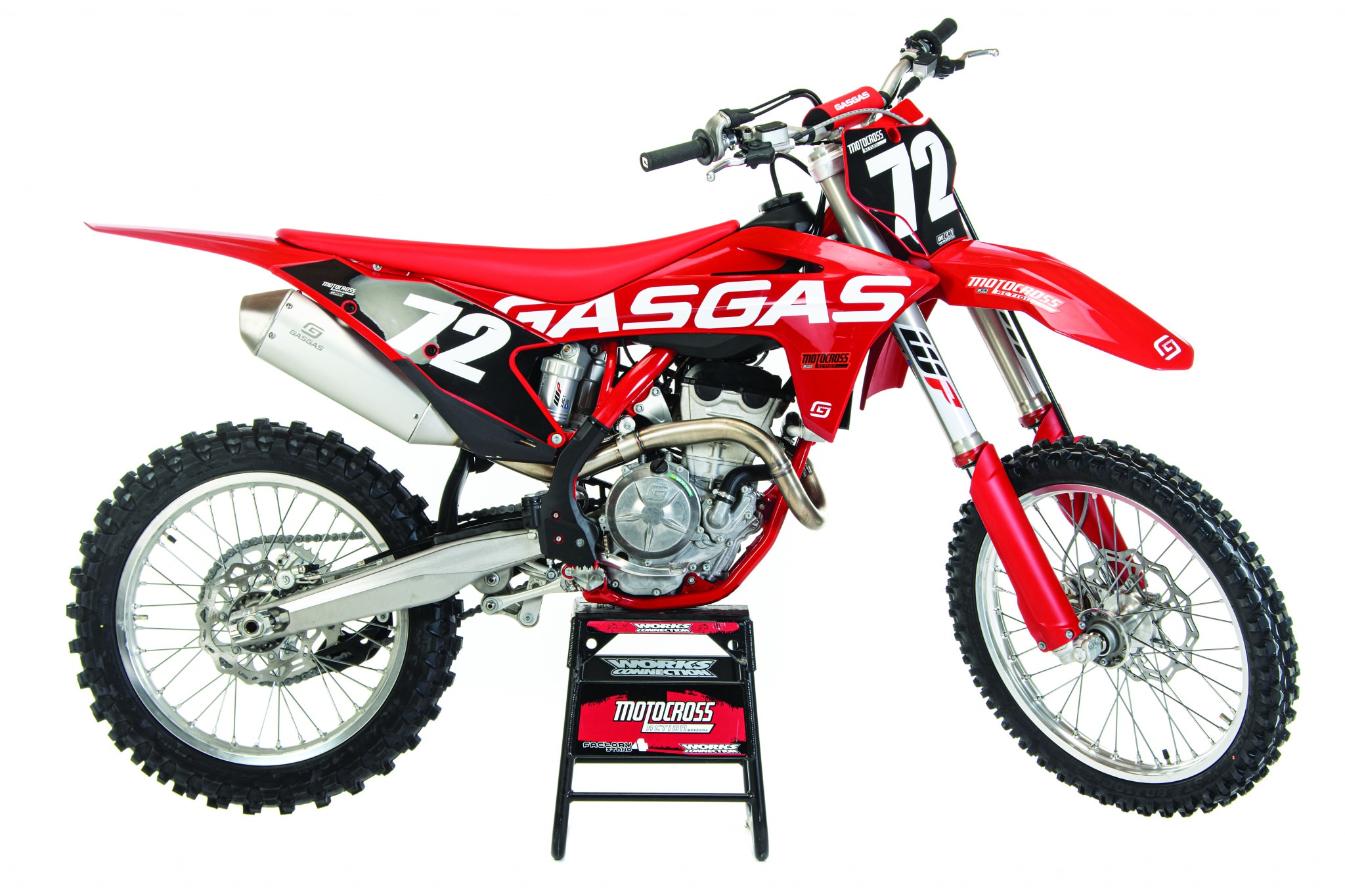 The 2021 GasGas MC 250F is not a red KTM. It might be from the same family, but has a different personality.
The 2021 GasGas MC 250F is not a red KTM. It might be from the same family, but has a different personality.
Q: WHAT’S DIFFERENT ABOUT THE GASGAS MC 250F AND ITS ORANGE AND WHITE STABLEMATES?
A: The GasGas engineers had to dance on the head of a pin to build a GasGas motocross bike that would be different enough from a KTM or Husky to give it the illusion of being an all-new machine, but not so different that it would scare potential buyers away. Here are the things that make those differences.
(1) Plastic. This is the most obvious difference, and also the most controversial. It’s red, and Hondas are also red; however, the GasGas machine is a deeper red than Honda’s Tahitian red. All the plastic on the GasGas is different from the Husky’s and KTM’s, save for the fork guards, mudflap and gas cap, which are the same.
(2) Triple clamps. Most racers think that the GasGas’ forged triple clamps are a first for the Austrian juggernaut. If we are talking about the motocross side, this is true; however, the same forged clamps that are on the GasGas MC 250F are on the KTM XC-W and EXC off-road models. On the Husqvarna side, billet clamps are used across the board. We recognize that one reason GasGas went with forged instead of billet was to keep the cost down—forged triple clamps are cheaper to make, especially if the molds already exist, than the CNC-machined billet triple clamps on the Husky and KTM motocross bikes. It is also possible that the GasGas engineers wanted the forged triple clamps because they would flex more than billet. Sure, every top pro in both off-road and Supercross uses the stiffer billet triple clamps, but let’s be honest, most of us aren’t pros. For most riders, controlled flex offers more feel and comfort than billet clamps. Too much flex or too much rigidity throws off the handling of a bike. Everything in moderation.
(3) Bar mounts. We have complained about the KTM rubber bar mounts twisting for years now. We liked the rubber mounting because it cut down on both engine vibration and rough ground clatter; however, the GasGas bar mounts are bolted straight to the forged clamps without any rubber buffer in between. What does this mean? Two things: (1) When we said that forged clamps made the GasGas have more flex, the billet-mounted bar mounts took some of that flex away. (2) Without the rubber buffer between the bar mounts, there is more vibration at the bars.
(4) Seat. The seat base is the same as the KTM base. It even has the same part number. Ours even had a KTM logo molded into the bottom of it. What is different are the seat foam and seat cover. The seat foam is noticeably softer than the KTM seat foam, and the shape of the seat is a bit more rounded; however, that might be due to the seat cover pushing the softer foam down. The seat cover material’s grip is between the very grippy KTM seat cover and the slick Husky cover; however, the softer foam of the GasGas seemed to give our riders more grip as they sunk into the seat more.
(5) Bar stops. You know those welded-on steel mounts on the front of your KTM or Husky frame that keep your handlebars from turning too far? On the GasGas, instead of a welded-on steel bar, they use adjustable bolts on both sides to lessen the turning radius (if you want to). You cannot increase the turning radius all the way, because it comes stock with the same turning radius as the KTM—and if the bars turned a 1/4 inch more, they would hit the radiator. But, you can decrease the turning radius by adjusting the bolts outward—this could be used to minimize tank slapping. We like having the option. 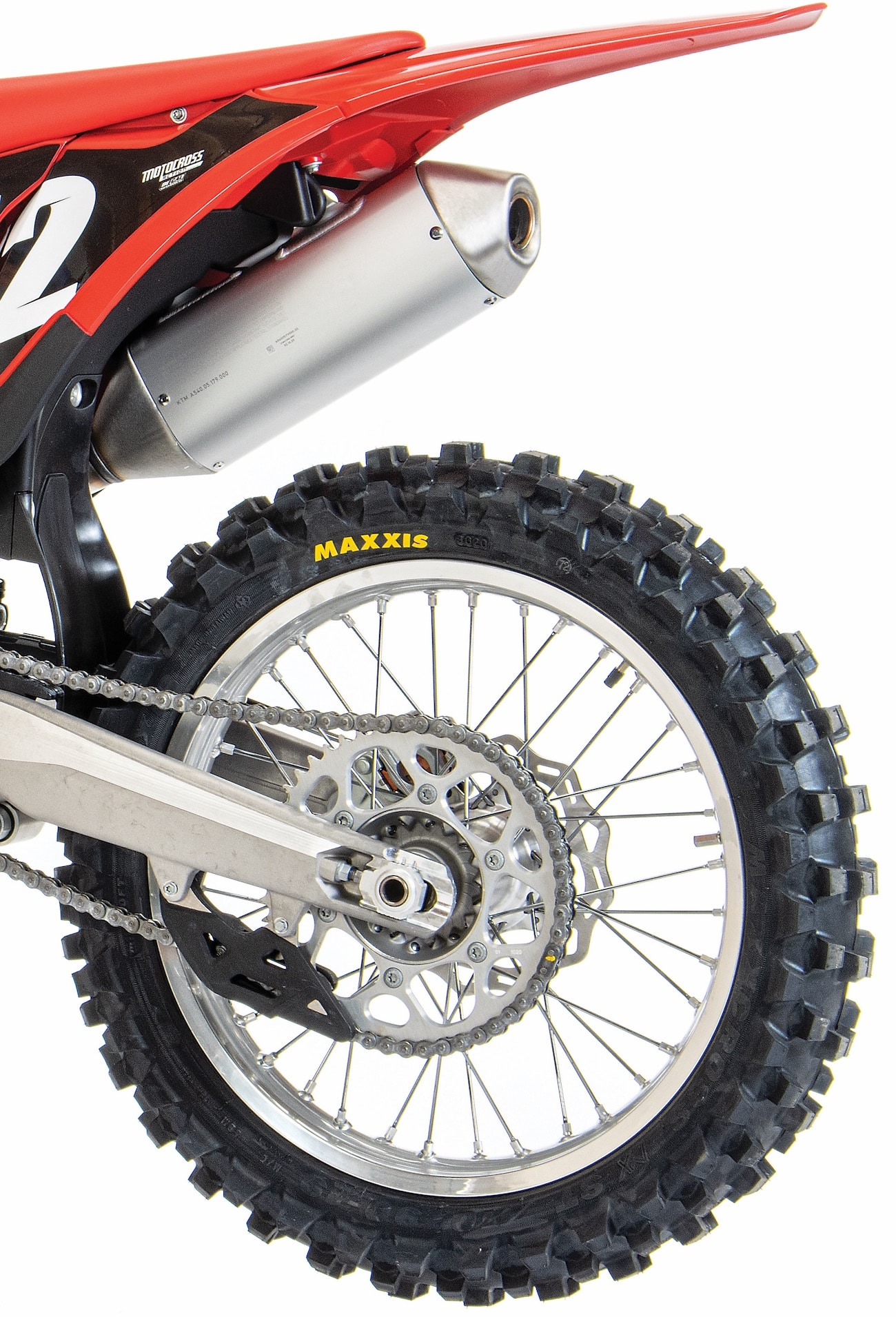
(6) Tires. GasGas is the only major motocross brand not to have Dunlops or Bridgestones as its OEM tires. We love the Dunlop MX33s that come on many of the 2021 bikes, but we don’t care much for the rear Bridgestone X30 that comes standard on the 2021 RM-Z450. GasGas chose Maxxis MaxxCross MX-ST tires. Previous Maxxis motocross tires had a reputation for being more durable than performance oriented. The Maxxis MaxxCross MX-ST is a performance tire. The rear tire offers exceptional grip and traction when used in intermediate terrain, while the front delivers good but not great grip when pushed hard. With that said, the tires are worth trying at your local track before swapping them out. You might be as surprised as we were.
(7) Map switch. The GasGas ECU comes with all the electronic goodies of the KTM and Husqvarna—except that it doesn’t have the push-button multi-switch to allow you to access Traction Control, Launch Control or Map 2. The stock map in the GasGas is the same map that comes standard as Map 1 on the FC250 and 250SXF. If you want to access all the maps, you will need to buy the plug-and-play map switch from your local GasGas, KTM or Husky dealer. It costs $170 and plugs in behind your front number plate. Piece of cake.
(8) Exhaust. Unlike the MC 450F, which has an ice-cream-cone insert in the muffler, the MC 250F has the same unrestricted muffler as the FC250 and 250SXF. What is different is the header. The MC 250F doesn’t have the bulbous resonance chamber that so many people think makes the four-stroke pipe look like a two-stroke pipe. It was a cost cutting move by GasGas and only cost the engine 1 decibel in sound tests.
(9) Hour meter. The 2021 GasGas MC 250F doesn’t come with the triple-clamp-mounted hour meter from the 250SXF and FC250, but that’s largely because there is no place to mount it on the slimmer and narrower forged GasGas triple clamps. You can buy an aftermarket hour meter from Works Connection for $44.95.
(10) Suspension. All three Austrian brands (KTM, Husky and GasGas) share the same WP XACT forks and shock. While the Husky and KTM have the same internal valving, the Husky forks are 10mm shorter. Additionally, the rear suspension of the Husqvarna gets a longer linkage arm, all-new bell crank and shortened stroke on the shock shaft, resulting in a 25mm reduction in seat height. As for the MC 250F, it is the only one out of the three Austrian machines that gets different valving. The valving is much like that of last year’s 2020 Husky FC250 but better. The setup is midway between an off-road and motocross suspension setup. The overall suspension setup is focused on being softer and more absorbent than typical motocross numbers but is still capable of managing big hits better than off-road forks.
(11) Price. The price of the GasGas MC 250F is $8499. That is $900 less than the FC250, $800 less than the 250SXF, $200 more than the KX250 and YZ250F, $500 more than the CRF250 and $600 more than the RM-Z250.
Q: WHY WOULD YOU BUY THE GASGAS MC 250F?
A: Simple. Affordability. You can get all the best parts that the KTM 250SXF offers for $800 less. The riders that this bike is designed for are weekend warriors. The target market is guys who ride a few times a month and want a bike that has all the potential to be a world better but none of the complexity. It has the status of KTM’s racing heritage while being reasonably priced and equipped with plush suspension. It doesn’t have all the bells and whistles of its Austrian brothers, but it is a pretty sweet ride without them. Most riders don’t bother engaging traction control or using launch control anyway. Be forewarned; the $800 savings over a KTM 250SXF is only a bargain if you don’t spend more than $800 adding aftermarket parts.
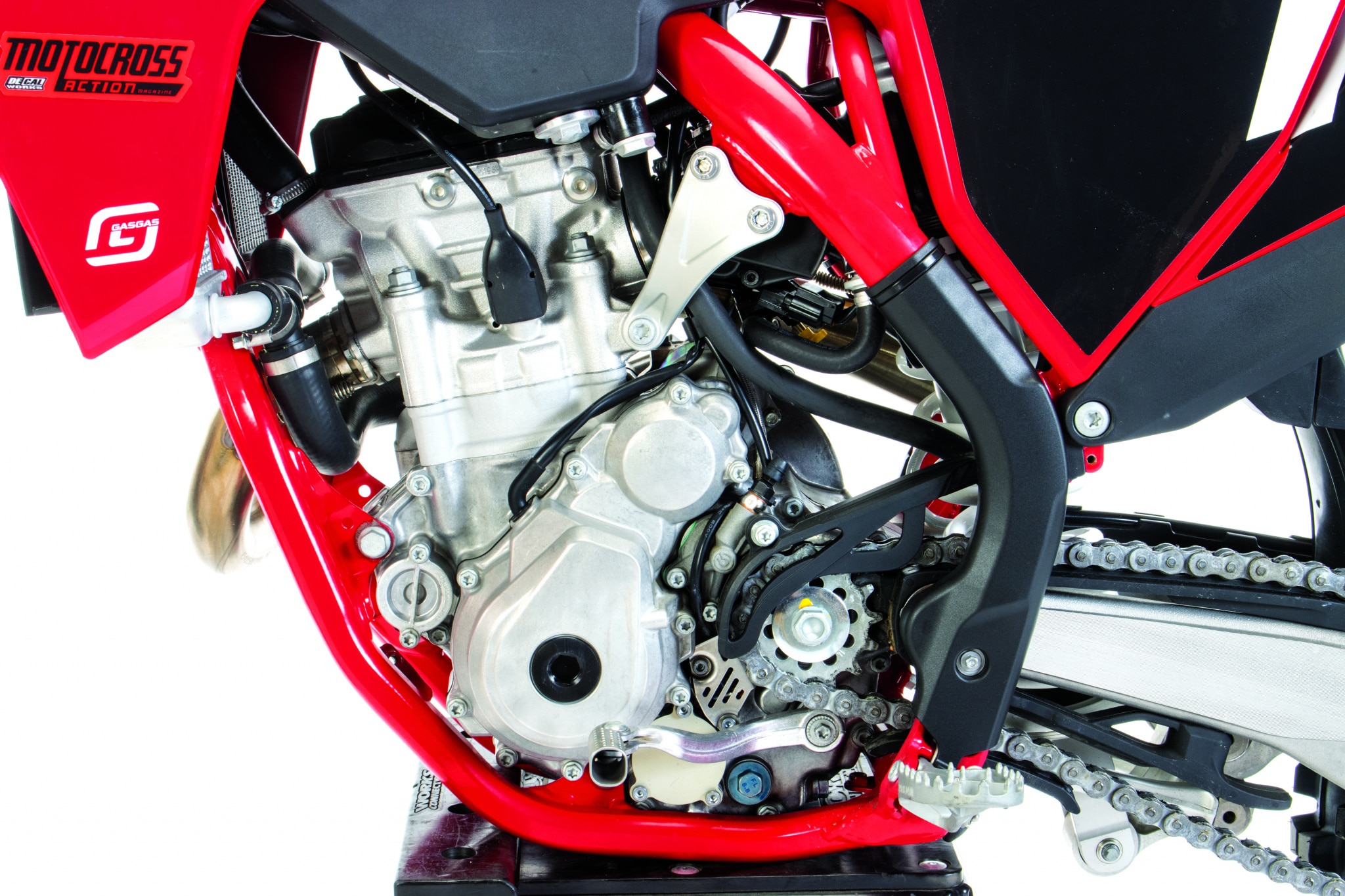
Q: HOW DOES THE MC 250F PERFORM ON THE TRACK?
A: Not as well as the KTM 250SXF. The MXA wrecking crew wasn’t surprised by this because this isn’t new for KTM. They have a track record of detuning the power characteristics of the other brands to keep the KTM the top dog in the corporate pecking order. KTM has been restricting airflow into Husqvarna engines since 2014. Since the GasGas MC 250F is the cheapest model of the Austrian trio, there was no way that the front offices could allow it to outperform the more expensive FC250 and 250SXF, right? The good thing about KTM sabotaging the GasGas’ performance by choking off the airbox is that it’s easy to get more air into the GasGas airbox. First, ride without the GasGas airbox cover to see just how much more power is available and if you like that feel. Second, cut the internal lip off the inside of the airbox cover. Third, if you still want more power, drill holes into the airbox cover (behind and above the air filter). Fourth, we tested with a vented KTM airbox cover on our GasGas air box. It fit well enough, as both the GasGas and KTM air boxes are identical.
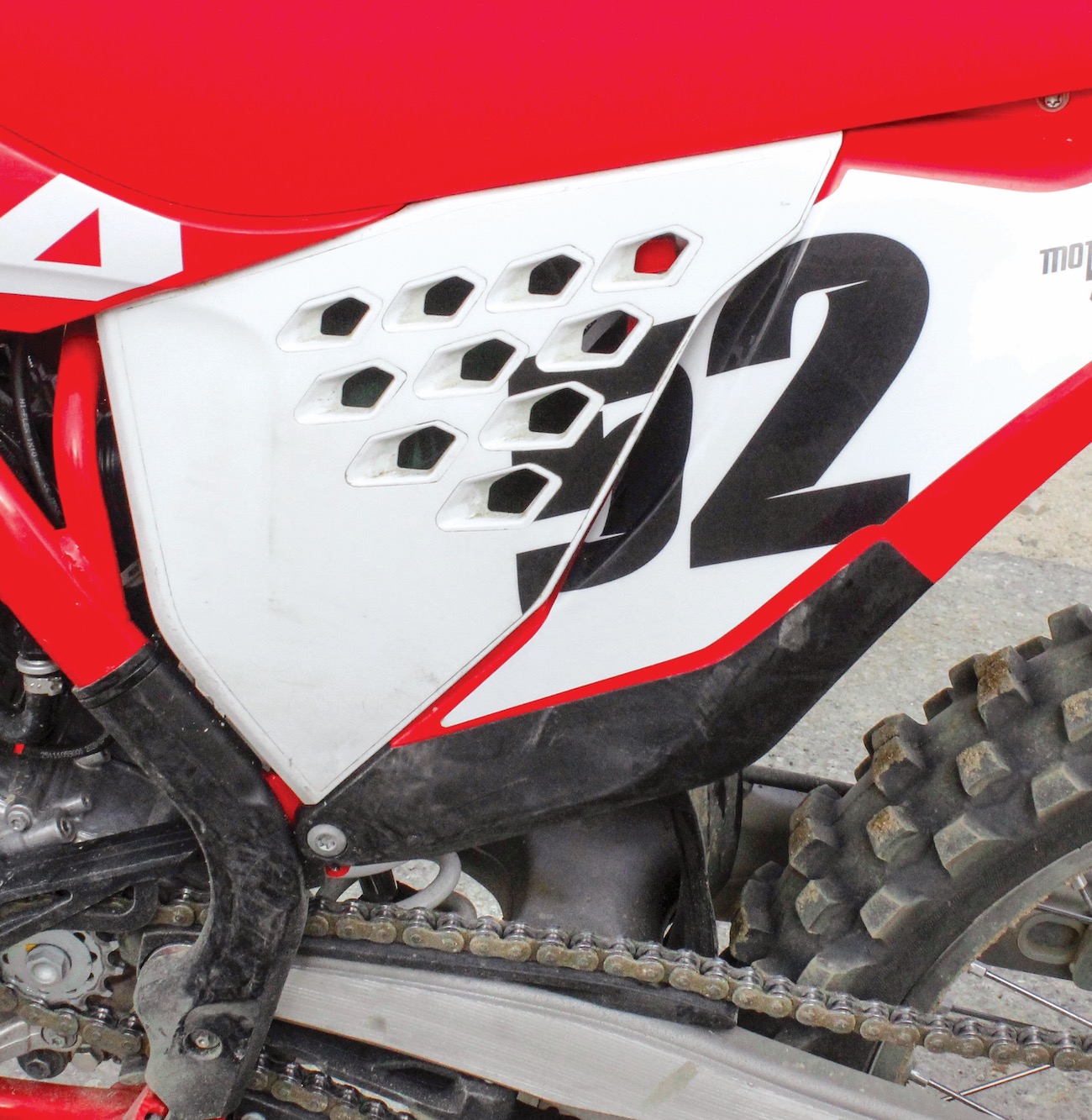
This is a powerful bike once it gets air into the engine. It pulls every bike in its class down the straightaways. If we leave the restricted airbox cover on, the power is smoother and accelerates slower. This isn’t necessarily a bad thing, as it makes the MC 250F very easy to ride. For many weekend warriors or newbies, the power characteristics of the stock MC 250F will be spot on. It is when you can’t make it over your local track’s big doubles that you may need to break out the Makita drill.
Q: HOW DOES THE MC 250F HANDLE?
A: The combination of the softer suspension settings in the WP components, forged triple clamps and Maxxis front tire makes the MC 250F handle differently from the KTM 250SXF. Not a big difference by any means, but noticeable. The MC 250F offers the same great straight-line stability and aggressive feel as its Austrian brothers. It does sit lower in the stroke with the softer suspension settings, and that made test riders complain about oversteer early in MXA’s test program. At first, we blamed the Maxxis tire, but after trying a Dunlop MX33, we shifted the blame to the forged aluminum triple clamps flexing. Finally, we, reset the torque specs on the triple clamps to 20 Nm on the top clamp and 15Nm on the bottom clamp (which is tighter than the 17Nm/12Nm of the KTM and Husky clamps. After that we experiemented with raiding and lowering the forks in the triple clmaps to fine tune the dront end response. All of this helped .
Of course, our Pro test riders wanted the taut precision of the billet clamps. The Maxxis front tire offered good traction, but just as with the clamps, when too much weight was on the front, riders didn’t like the tire’s feedback. It wanted to push when the front end was weighted heavily. In the end, we went tire shopping for a better front but left the rear Maxxis on.

Q: WHAT DID WE HATE?
A: The hate list:
(1) Air box. GasGas needs to offer an optional airbox cover like KTM and Husky so the engine can breathe. The stock one is very restrictive.
(2) Spokes. The spoke by the rim lock comes loose quickly. Watch it closely on day one and every other day after that.
(3) Bleed screws. Please change the fork’s bleed screws from Torxs back to the Phillips screws from a few years ago.
(4) Preload ring. The plastic preload ring needs to be beefed up—it gets chewed up easily.
(5) Fork adjuster. The thin, short fork clicker adjuster hurt your fingers after a few clicks.
(6) Bar pad. The GasGas bar pad looks like it was made for the GasGas MC 50cc mini. It’s stylishly small but minimally protective.
(7) Front tire. We think the Maxxis rear is a good tire, while the front still needs Jeremy McGrath to do a little more testing.

Q: WHAT DID WE LIKE?
A: The like list:
(1) Weight. The Husky and KTM were the lightest bikes in the class, but the GasGas is almost a pound lighter because of the things it doesn’t come with: billet triple clamps, a resonance chamber, map switch and overdone plastic parts.
(2) Brakes. The GasGas shares the KTM’s great Brembo brakes.
(3) No tools. If you like the KTM no-tools airbox (we do), the GasGas airbox is the same. It is easy to get to and easy to put back on once you get the hang of it.
(4) Hydraulic clutch. The Brembo hydraulic clutch does all the work and takes a beating.
(5) Power. The 250SXF, FC250 and MC 250F all share the best engine in the class. Why? Because the engine is identical on the three bikes, leaving any differences to the airbox design.
(6) Ergonomics. The GasGas MC 250F offers more flex and comfort than the other two Austrian bikes, making it easier to adapt to. Minimal changes are needed to feel comfortable.
(7) Suspension. The only riders who won’t love the suspension setup are fast guys, but even they were impressed with the bottoming capabilities. They couldn’t bottom the XACT forks. We actually took a lot of oil out of the forks to get more travel.
(8) Lock-on grips. We have taken a liking to the standard ODI lock-on grips.
(9) Price. Anybody who says that an $800 price cut isn’t a big deal needs to take the silver spoon out of his helmet.

Q: WHAT DO WE REALLY THINK OF THE 2021 GASGAS MC 250F?
A: We think Stefan Pierer’s business plan is going to put a lot more money in his coffers. His three brands offer the same basic platforms but serve the needs of three different types of riders. The GasGas MC 250F has already gone through its teething phases—after all, the chassis and engine have already had years of R&D put into them. If you want a red bike that offers the same powerful brakes, bulletproof electric starter, no-tools airbox, lock-on grips, time-tested engine, hydraulic clutch, braided steel brake hoses, steel clutch basket and class-leading light weight at a discount, the MC 250F is for you. 
MXA’S 2021 GASGAS MC 250F SETUP SPECS
This is how we set up our 2021 GasGas MC 250F for racing. We offer it as a guide to help you find your own sweet spot.
48MM XACT FORK SETTINGS
In stock trim, the WP XACT forks offered a plush setting that still featured excellent bottoming resistance. Most riders didn’t drift away from the stock clicker settings. When we noticed that even our fastest Pro test riders weren’t using all of the WP fork’s travel, we lowered the oil height to enable them to use the entire stroke. Test riders did notice the front end would oversteer at times, but sliding the forks down in the clamps to between the first and second line solved the problem. For hardcore racing, we recommend this fork setting for an average rider on the 2021 GasGas MC 250F (stock specs are in parentheses):
Air pressure: 151 psi
Compression: 12 clicks out
Rebound: 12 clicks out
Fork-leg height: One and a half lines (Second line)
Notes: Remember to check pressure every day that you go out, and be sure to bleed those pesky air screws to release built-up incidental air pressure. Don’t be afraid to lower the air pressure or turn the compression clicker farther out—MXA has test riders who run the air pressure as low as 135 psi and clickers as far out as 20.
WP SHOCK SETTINGS
This is a good all-around shock. Although we do make clicker adjustments, we rarely stray far from the stock 15 clicks out on compression. It can be dialed in with only a few clicker changes. As a rule of thumb, most MXA test riders leave the low-speed compression on the stock setting and focus on the high-speed dial to make the changes. For hardcore racing, we recommend this shock setup for the 2021 GasGas MC 250F (stock specs are in parentheses):
Spring rate: 42 N/mm
Race sag: 105mm
Hi-compression: 1.5 turns out
Lo-compression: 15 clicks out
Rebound: 15 clicks out
Notes: The stock shock spring has a 42 N/mm rate, which is also the same spring rate as on the GasGas MC 450F; however, on the 450, the shock spring is not firm enough to allow a rider over 185 pounds to get free sag numbers between 30mm and 40mm. Luckily, 185-pound 250 four-stroke riders are rare.


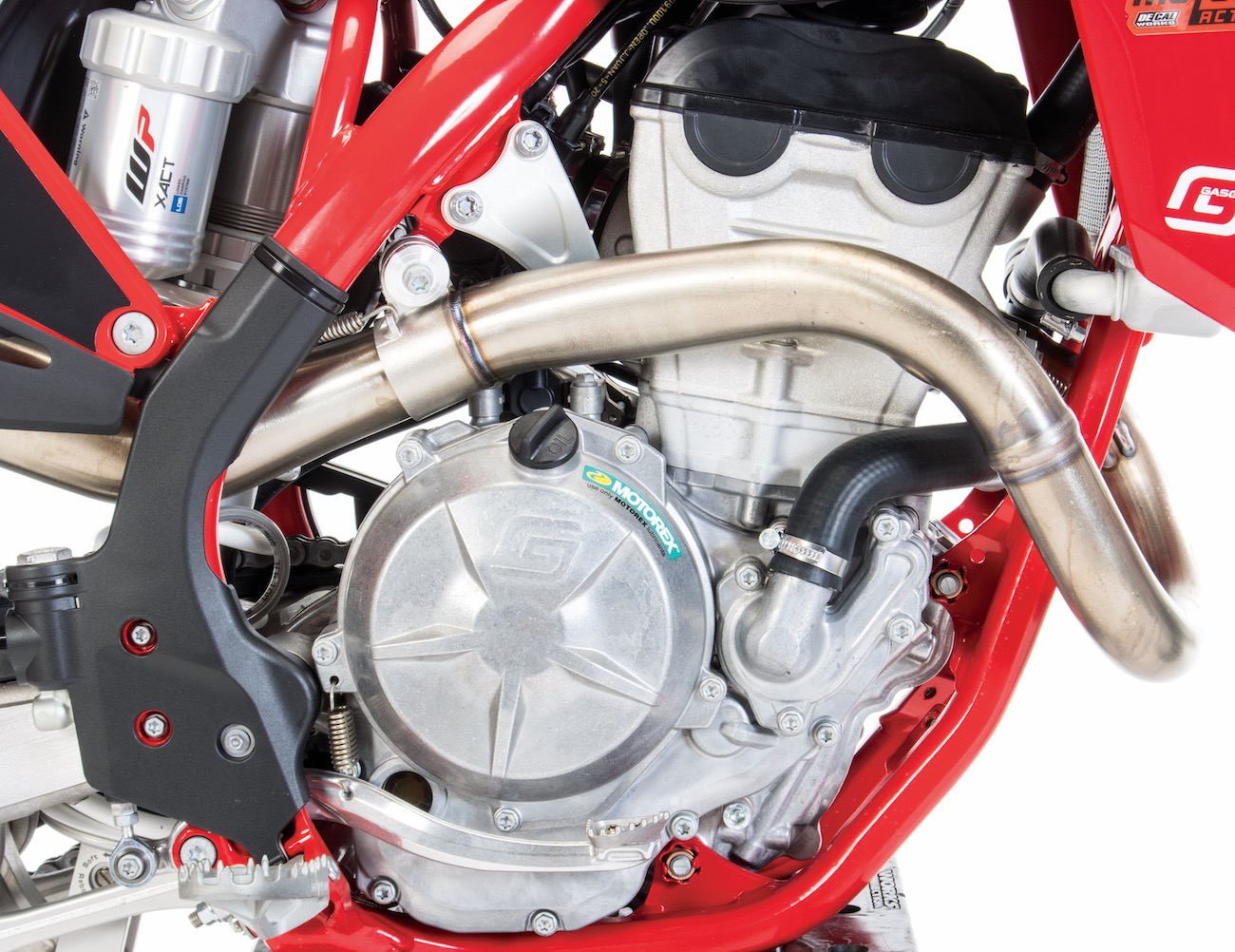




Comments are closed.